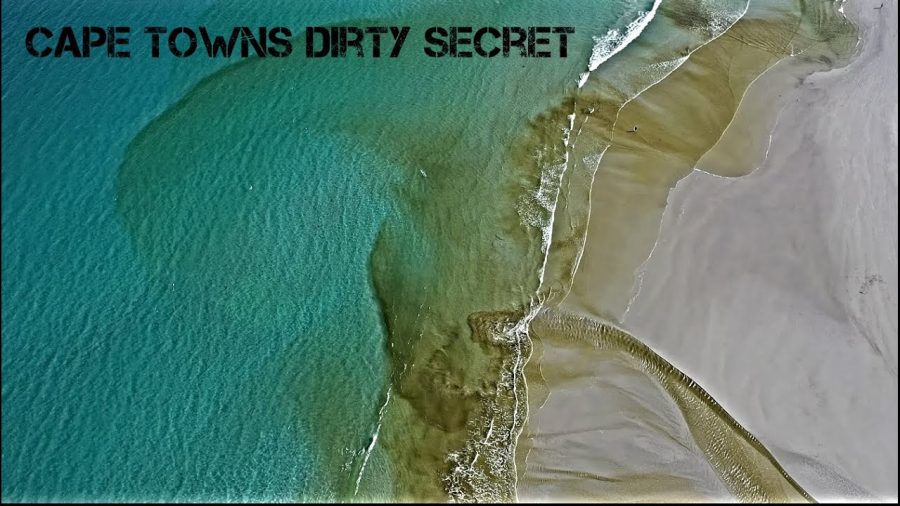
WATCH ‘Toxic Waste’ Pours into Cape Town Ocean. City of CT Responds.
Western Cape YouTuber Adam Spires posted a video last week appearing to expose the pollution being washed into the Atlantic Ocean in iconic Cape Town. Spire’s aerial footage (which he calls “shocking”) seems to show sewage pouring into the ocean of one of the most popular holiday destinations in the world… BUT, according to the […]

Western Cape YouTuber Adam Spires posted a video last week appearing to expose the pollution being washed into the Atlantic Ocean in iconic Cape Town. Spire’s aerial footage (which he calls “shocking”) seems to show sewage pouring into the ocean of one of the most popular holiday destinations in the world… BUT, according to the City of Cape Town, the footage is not what it seems. See below…

“The footage that has been widely circulated is the growth of an algal bloom in the lagoon,” Alderman Xanthea Limberg, Mayoral Committee Member for Water and Waste in Cape Town, told SAPeople.
Spires said he decided to investigate the apparent waste seeping into Cape Town’s oceans after receiving so many requests from disgruntled Capetonians.
In his vlog, posted on Friday, Spires shows a drainage pipe in Milnerton that was intended to release rainwater, but which he says is instead spewing sewage. The video also shows used condoms and nappies lying on the sand.
But that isn’t the worst of it – it’s the stench that gets to Spires who refers to the “smell” and “stink” a few times.
There is a warning sign on the beach stating: “Polluted water: for health reasons, swimming and recreational activities in these waters are at your own risk.”
To get a better idea of the situation, Spires decided to see what it looked like from the air. During the helicopter trip, a fellow passenger can be heard saying “look how much poo is coming in here from the river”.
However, apparently what they were viewing was not sewage! But first, watch the video here:
WATCH Adam Spires’ Aerial Footage Shows ‘Toxic Waste’ Pouring into Cape Town’s Oceans:
“The brown plume of algae-rich water was mistaken for raw sewage flowing into the ocean” – Alderman Xanthea Limberg
Cape Town’s Limberg told SAPeople that “the public tends to associate the brown/green colour in the water with raw sewage”… but it’s algal bloom.
A proud local resident also refutes Spires’ claims. The resident, who was at Milnerton Lagoon this weekend, took the below video footage on Sunday after she went “looking for the proverbial turds to come by”.
Her footage shows no sewage to be found. She also said there was no smell at all and “if anything it’s nice and fresh”.
WATCH Local resident at Milnerton finds no sewage
The Problem and How It Has Been Addressed
Limberg explains what took place in December 2019. He says: “At any given time, the growth of an algal bloom is as a result of excess nutrients from wastewater, fertilizer, and storm water runoff that is coupled with lots of sunlight, warm temperatures and shallow, slow-flowing water.” (Similar scenes can be seen in Australia during the summer.)
This happened in December, and the problem has been addressed.
“In a joint operation between multiple City departments the work undertaken in December yielded a positive result,” he says. “The plan was to help the lagoon cope with the high levels of pollutants, and one of the best ways to do this was to get as much sea water into the system as possible. This in turn replicated a healthy natural functioning estuary.

“The wider and deeper lagoon mouth allowed for increased flow of sea water into the lagoon, which is most effective in counteracting eutrophication, or the scenario in which algae is flourishing and consumes all of the oxygen in the water.
“The artificially widened lagoon mouth allowed high-tide ingress into the estuary, and when low tide occurred, the polluted and algae-rich water was naturally drawn out into the ocean.”
Limberg says: “Loaders worked to deepen the opening. Honey Suckers were also brought in to pump contaminated water from the Theo Marais canal back into the sewer system for treatment at the wastewater treatment plant.
“The Theo Marais canal runs through densely populated areas which have experienced high numbers of unplanned informal settlements. This represents a significant contribution to the overall water quality challenges.
“The Theo Marais canal also drains the industrial large catchment of Montague Gardens which may deliver contamination to the stormwater system.” (See more of the sources of the pollution below the video.)
WATCH Milnerton beach, 02 February 2020
Although Spires didn’t seem to realise it was algal bloom he was filming, he does raise an important point – “It’s about making sure we don’t dump stuff down the drain.”
The City of Cape Town’s Alderman Xanthea Limberg, Mayoral Committee Member for Water and Waste, has kindly provided the following information on current and proposed plans, and guidelines for residents:
Diep River Catchment:
“The Diep Catchment is very large and has an extensive stormwater reticulation network with many other stormwater outlets which cannot be monitored individually due to their sheer number. Any sewage spills taking place in the catchment have the likelihood of entering the stormwater system and being delivered to the river / lagoon.
“Options and ideas around the longer term manipulation of flows, mouth management and even dredging (as possible ways to assist the system in the longer term) are being explored. However, these interventions need to be carefully considered as they could lead to other undesirable consequences.”
Potsdam Wastewater Treatment Works upgrade project – cost R1,7 billion:
“While there have been operational challenges at Potsdam, especially during 2019 with its UV sterilization and dewatering processes, these issues have largely been resolved.
“Potsdam is in the process of being upgraded and a new Membrane Bio Reactor unit will be added. The total design capacity of the plant will be 100 M/l per day.
1 Demolition R16 Completion Jan 2020
2 Civil Works R710 Completion Dec 2023
3 M&E Works R970 Completion Dec 2024”
Proposed Diep River Water Quality Projects

Sources of pollution
“Residents in this area have been blaming the Potsdam WWTW for the pollution of the lagoon. However, there are various sources of pollution, not just the Potsdam Wastewater Treatment Works (WWTW).
“The issues further upstream along the Diep River catchment that lead down to the lagoon, is where the problems begin.
“Contamination in these systems cannot be easily identified and traced down to a single source as they represent large catchments with a number of possible causes, but we do know that among the sources are the following:
- Irresponsible use of the sewer system by local residents and businesses leading to blockages and overflows which can contaminate the lagoon.
- Landscaping/agricultural activities upstream (fertilizer)
- Illegal informal development which blocks the City’s access to its sewage infrastructure and obstructs efforts to minimise the impacts of blockages.
- Backyard tenants who are not provided with toilets by their landlords, which leads to human waste being disposed into the stormwater system, which flows into rivers and eventually the ocean.
“It must be understood that reasons for poor water quality are complex and include natural causes such as drought, high temperatures and the closing of the river mouth. Other factors such as cable theft pose a challenge, which is what caused the Table View East pump station failure in October 2019, leading to a sewerage spill.
“Teams have been working to clear hyacinth growth in the river which may have dislodged some of the pollutants from the spill and caused them to flow downstream to the lagoon.”
Engagement with community
“A range of City representatives met with members of the community on Monday evening and shared progress of plans and investments to alleviate challenges in the catchment, which was followed by a question and answer session. This is one of several meetings that have taken place between the City and the community recently, and the City is committed to sustaining a close working relationship with the residents as we drive the projects to improve water quality.”
Solutions
“The City is committed to seeking solutions to a complex problem.
“There are three teams working on hyacinth clearing:
- One team at the Blouberg Road bridge near Heron Waters
- One team is at the R27 bridge area
- One team is opposite the Milnerton high school
“Total area cleared to date is 3km mechanically from R27 up to Potsdam. One remaining kilometre must now be done by hand. Mechanical follow up cleaning will happen in June this year.
“The Diep Catchment is very large and has an extensive stormwater reticulation network with many other stormwater outlets which cannot be monitored individually due to their sheer number. Any sewage spills taking place in the catchment have the likelihood of entering of the stormwater system and being delivered to the river / lagoon.
“Options and ideas around the longer term manipulation of flows, mouth management and even dredging (as possible ways to assist the system in the longer term) are being explored. However, these interventions need to be carefully considered as they could lead to other undesirable consequences.
“While there have not been any spills of untreated wastewater into the Diep River from the Potsdam Wastewater Treatment Works, there have been operational challenges at the facility that are causing high levels of ammonia in the sludge.
“The City doses with chlorine chips to help with the disinfection performance, but performance remains variable. Staff are working to speed up the procurement process to install a third mobile belt press, which is expected to come online in February 2020. Sludge concentrations are currently in the process of being lowered (with the two existing belt presses) but this will speed up once the third press is operational.
“City officials are dedicated to alleviating pollution, but residents are reminded that in a situation like this there are no quick fixes. The reality is rapid growth and urbanization in our city, combined with the length of time it takes to legally and appropriately enhance infrastructure to keep pace with the growth in demand, means that our ability to control pollution will remain a challenge across the city for some time.”
